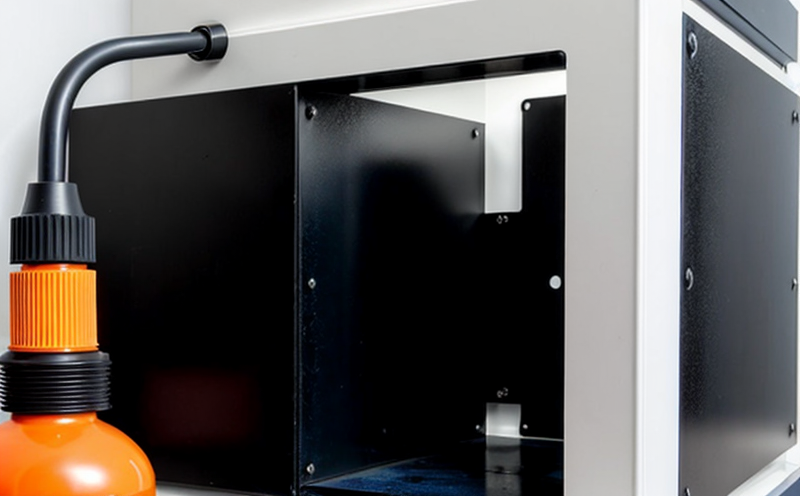ISO 2409 Cross Cut Adhesion Test for Nanocoatings
The ISO 2409 cross cut adhesion test is a standard method used to evaluate the adhesion strength of nanocoatings. This critical assessment helps ensure that nanocoatings remain robust and intact under various environmental conditions, which is essential in sectors such as automotive, aerospace, and construction where durability and performance are paramount.
The test involves creating a series of cuts across the surface of the sample, typically using a razor blade or scalpel. After the cuts are made, an adhesive tape is applied over these cuts and removed quickly. The residual layer of coating left behind after peeling off the tape is then visually assessed for its adhesion properties.
The ISO 2409 standard specifies the dimensions and spacing of cross cuts as well as the type of adhesive tape to be used. This ensures a consistent testing methodology across different laboratories, enhancing the reliability and comparability of test results. The method is particularly useful in nanocoatings where even slight variations can impact overall performance.
The adhesion properties of nanocoatings are crucial for their success in various applications. For instance, in automotive coatings, poor adhesion could lead to premature peeling or flaking, compromising the aesthetic appeal and protection provided by the coating. In aerospace, durability is critical; even a small breach can have significant safety implications.
The test results provide valuable insights into the quality of nanocoatings during various stages of development and production. By identifying potential weaknesses early on, manufacturers can make necessary adjustments to improve product performance. This is especially important in sectors where stringent regulatory requirements are enforced, ensuring that products meet not only performance standards but also environmental and sustainability criteria.
The ISO 2409 cross cut adhesion test is a cornerstone of quality control processes. It ensures that nanocoatings adhere as expected under real-world conditions, thereby enhancing the reliability and longevity of finished products. This method plays a vital role in maintaining high-quality standards across diverse industries, including automotive, aerospace, construction, and electronics.
Understanding the parameters involved in this test is crucial for accurate interpretation of results. The standard specifies the use of specific tools such as a razor blade or scalpel to create precise cuts with defined dimensions. The application and removal of adhesive tape must be done swiftly and uniformly to ensure consistent results. Visual assessment of the residual coating after peeling off the tape provides immediate feedback on adhesion strength.
The importance of this test cannot be overstated, especially in industries where nanocoatings are used to enhance product performance and durability. By ensuring that these coatings adhere properly, manufacturers can extend the lifespan of their products, reduce maintenance costs, and improve overall customer satisfaction.
- Consistency in testing methodology across laboratories
- Enhanced reliability and comparability of test results
- Identification of potential weaknesses early on during development and production stages
- Promotion of high-quality standards across diverse industries
The ISO 2409 cross cut adhesion test is a fundamental tool for quality managers, compliance officers, R&D engineers, and procurement specialists. It ensures that nanocoatings meet stringent performance criteria, thereby enhancing the reliability and longevity of finished products.
Industry Applications
The ISO 2409 cross cut adhesion test is widely used in several industries where nanocoatings play a crucial role. In the automotive sector, this test ensures that protective coatings on vehicles remain intact under various environmental conditions, including exposure to sunlight, rain, and extreme temperatures. This is vital for maintaining the aesthetic appeal and protection of the vehicle.
In aerospace applications, the robustness and durability of nanocoatings are critical due to the harsh operating environments in which aircraft and spacecraft operate. The test helps ensure that coatings adhere effectively, preventing any potential failure under high-stress conditions.
The construction industry also benefits significantly from this testing method. In buildings exposed to outdoor elements, ensuring proper adhesion of protective and aesthetic nanocoatings is essential for longevity and durability. This enhances the overall performance and safety of structures.
In electronics manufacturing, nanocoatings are used to protect delicate components from environmental factors such as moisture and dust. The ISO 2409 test ensures that these coatings adhere securely, providing the necessary protection without compromising on performance.
Overall, this testing method is indispensable for ensuring high-quality standards in various industries where nanocoatings contribute significantly to product reliability and longevity.
Environmental and Sustainability Contributions
- Eco-friendly materials: By improving the adhesion of nanocoatings, this test ensures that coatings remain intact, reducing waste and environmental impact.
- Sustainable manufacturing: Ensuring strong adhesion during production minimizes material usage and resource consumption.
- Reduced maintenance: Strong adherence leads to longer-lasting products, reducing the frequency of re-coating or replacement, which in turn conserves resources.
The ISO 2409 cross cut adhesion test plays a pivotal role in promoting sustainability by enhancing the performance and longevity of nanocoatings. This, in turn, contributes to more efficient use of resources and reduced environmental impact across various industries.
Use Cases and Application Examples
The ISO 2409 cross cut adhesion test is applicable in numerous scenarios where nanocoatings are used. Here are a few examples:
- Aerospace coatings: Ensuring that protective coatings on aircraft remain intact under extreme conditions.
- Automotive finishes: Guaranteeing that car paint and protection layers adhere firmly to the vehicle body, enhancing durability.
- Construction materials: Maintaining the integrity of building facades and surfaces against environmental stresses.
- Electronics packaging: Protecting sensitive components from external elements in harsh environments.
In each of these cases, the test helps ensure that nanocoatings perform as expected, contributing to improved product reliability and longevity. This is particularly important for industries where performance under challenging conditions is critical.





